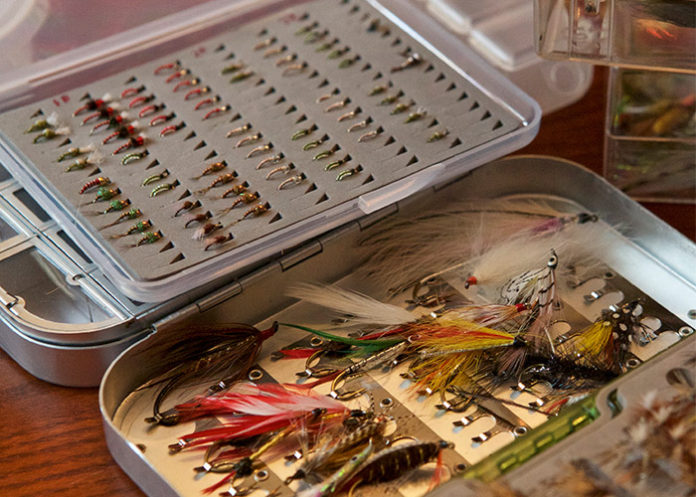Written by: Debra Carr Brox
March is the time for spring cleaning. Getting my fly boxes in order is a monumental task.
Photo by Debra Carr Brox
Every March, in anticipation of the fishing season ahead, I organize my fly boxes. It’s a monumental task. Not only are the boxes in disarray, but there are wool patches, hats, containers from fly shops, Tupperware, trays, glove boxes, and pockets that need to be emptied, as well. Once all the flies have been collected on the kitchen table, a strategy must be conceived. I’ve tried many different approaches.
By type—all nymphs in one box, streamers in another, hoppers in another, etc. This results in a large number of boxes needed for each outing. Though I appreciate being prepared for anything, this method requires me to stuff my vest with six or so fly boxes, making it difficult to cast and impossible to see my feet. Also, trying to find the fly I need quickly is an exercise in futility.
By region—this includes Eastern, Western, Canada, and Tropical. Using this strategy, I invariably do not have the pattern I need and end up at a nearby fly shop to add to my selection. This is not the worst thing, because it always helps to tap local knowledge for what’s working. However, I’m also forced to buy duplicates of flies that I have back home in a different box.
By river—I’ve had boxes for Silver Creek and Henry’s Fork in Idaho, Salmon River in New York, the Penobscot in Maine – I even had a box specifically for the Big Hole in Montana. This method was by far the least successful. The only instance where organizing by body of water really works is Canada for Atlantic salmon and tropical for bonefish, permit, and tarpon.

A sound strategy is needed to turn this mess into an efficient arsenal.
Photo by Debra Carr Brox
Then there is the “favorites” fly-box option, filled with just the classics. I have found that a trout is a trout, and they like certain bugs, no matter where they live. That was proven on trip to Tierra Del Fuego in Argentina. My husband and I were there to catch the famed sea-run browns, the cover story on all the fishing magazines. Our guides (from Montana) insisted that we needed huge bunny streamers to attract the big, aggressive fish. For two days we tried, with no luck. On the third, we were assigned to a local fishing guide, who was more willing to let us experiment. Considering the situation, we both tied on a fly we felt to be tried-and-true–a Beadhead Hare’s Ear Nymph–and we both hooked and landed a 10-plus-pound brown. Back at the lodge, dinner conversation became strained when the others found out about our success. We were the only ones catch sea-runs the entire week.
The easiest choice would be to have a fly box for all the scenarios I mentioned. Let’s see…that would require about 20 fly boxes, and and average of 50 flies per box. I’m not sure that’s prudent. Plus, I don’t tie flies myself. I place orders with my husband, who ties, or buy I them. Often, when I step up to the cashier at a fly shop, I have so many flies that the guy asks where I guide! When I tell them I’m not a guide, they always suggest I take up tying. I smile and agree, but have no more intention of becoming a cobbler to support my shoe habit than of becoming a fly tier to keep myself in BWOs. That would require the purchase and organization of a truly overwhelming amount of stuff and a place to store it.
Comedian Steven Wright said, “You can’t have everything…Where would you put it?” I must resign myself to the fact that I can’t have every fly for every possible situation and location. My solution is to always have a flask. That way, if I can’t match the hatch, I can enjoy good scotch while I wait it out.
Credit: Source link































